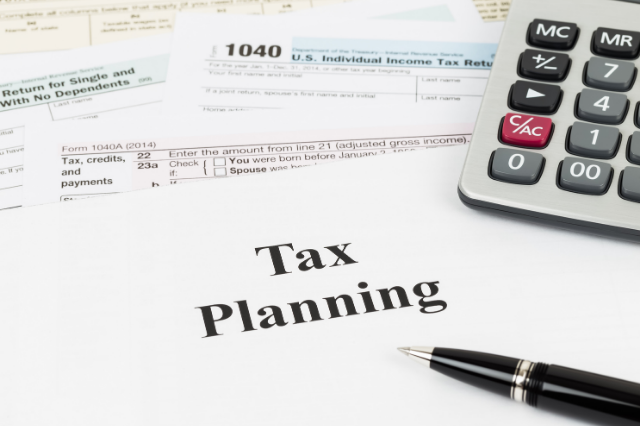It’s April, so the tax articles have to keep on coming! Welcome to part 2 of our tax mini-series. Today, we’re going to dive into our final tips to help bring tax efficiency to your money year-round.
As always, be sure to work with your CPA before implementing any strategies or ideas into your plan.
Let’s dive in!
Make your investments work (hard) for you.
You can and should structure your investments in tax-efficient ways. Doing so involves several factors including the following strategies:
- Portfolio assessments
- Are your portfolios aligned with your investment goals, time horizon, and risk preferences? Are your rebalancing strategies also aligned with these goals?
- Risk tolerance and capacity
- What level of risk are you willing to put in your portfolio and how much do you need to pursue your goals?
- Asset allocation
- What is the most appropriate mix of securities for your portfolio needs?
- Asset location
- How can you help improve the tax efficiency of your securities?
Each of these components works together to create a cohesive and tailored strategy fit with your unique goals and objectives in mind. One of the most critical is asset location.
Why asset location promotes tax efficiency
Essentially, this strategy seeks to help increase return and help reduce taxes by placing certain securities in the most tax-efficient accounts.
Think about this like virtual merchandising— a tactic used in the retail industry to optimize a product and prime the customer for purchase. Where you place an item in a store really matters. Consider a new release at a book store. The shop owner likely wouldn’t make customers dig through convoluted sections—the fresh release would be front and center.
The same is true for the securities in your portfolio. Each of your investments has different tax treatments and depending on the account they are stored in, different tax liabilities. Let’s boil this down to the basics. In general,
- Tax-efficient assets like stocks are often better suited for tax reasons in a taxable account like a brokerage account.
- Tax-inefficient assets like bonds are often better suited for tax reasons in a tax-deferred or tax-free account like a Roth IRA.
But this process should be dependent on your specific needs. For example, you might want to place high-growth assets like stocks in a Roth account. While stocks are efficient from a capital gains perspective, if they are stored in a Roth, the higher growth would be tax-free. There are several different strategies that you and your advisor can consider.
Certain assets perform better in different accounts like certain plants grow better in particular environments. A tropical hibiscus likely wouldn’t thrive in Alaska’s arctic tundras the same way it would in a Florida garden, for example, just like a bond would yield more taxes in a taxable account as opposed to a Roth account.
Donate throughout the year.
Regular charitable contributions can go a long way toward helping improve your tax efficiency throughout the year. If charitable giving is an important part of your financial plan, consider the following methods for maximizing your donations.
Give with a qualified charitable distribution (QCDs)
QCDs allow you to donate up to $100,000 from a traditional IRA to a qualified charity. There are several benefits for giving with this method.
- You don’t have to itemize to take advantage of this strategy.
- Retirees can donate all or a portion of their required minimum distributions (RMDs), further reducing their tax liability.
- By not paying taxes on the gift, you maximize your contributions.
Keep in mind that to work properly, a QCD must be initiated by the IRA custodian directly to the charity of your choosing. The charity must also be a 501(c)(3) organization, meaning private foundations and donor-advised funds don’t qualify.
Consider a donor-advised fund (DAF)
A donor-advised fund is a charitable giving investment vehicle. You set up an account with a financial institution, which manages the investments. Then, you contribute appreciated assets or other investments and recommend charities or organizations to receive the funds. There are some important tax advantages but they can be complex, so turn to your financial advisor for help regarding your situation.
Work with a trusted financial advisor
As you can see, taxes infiltrate nearly every aspect of your financial life. It’s essential to have a trusted professional work with you and your CPA to build a tax strategy that works for you year-round. Prioritizing your tax responsibilities throughout the year seeks to reduce the amount of taxes you pay throughout your life.
When not structured properly, you could incur more taxes than necessary, which takes more money from your nest egg and your ideal retirement lifestyle. We love working with people to help them keep taxes top of mind with every financial decision.
Tax planning is proactive and forward-thinking, two elements critical to a successful financial life. But as with every piece of financial advice, general just isn’t going to cut it. You need professional, personal, and tailored advice that fits your goals, values, and priorities both now and in the future. Be sure to work with your tax professional before making any changes to your plan.
If you’d like to discuss your particular situation, schedule a call with our team today. We can’t wait to help you!
Investing involves risk including the potential loss of principal. No investment strategy can guarantee a profit or protect against loss in periods of declining values. Past performance is no guarantee of future results. Please note that individual situations can vary. Therefore, the information presented here should only be relied upon when coordinated with individual professional advice.
There is no guarantee that a diversified portfolio will outperform a non-diversified portfolio in any given market environment. No investment strategy, such as asset allocation, can guarantee a profit or protect against loss in periods of declining values.
